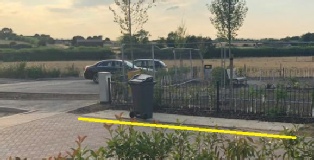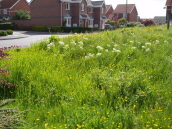




What to look at when buying a new home:
Location of proposed street furniture
Your dream home may not be so appealing if you have any of the following directly outside your frontage: - Road signs, waste bins, seating, bus stops or post boxes. Find out where these may be located.
When looking at site layouts watch out for bin collection points (BCP). Many new homebuyers find out that an area adjacent to their home or worse, part of their property is allocated as a BCP. Not only has this the potential for disputes with neighbours using the BCP but would also make the home less desirable when it is time to move on. It has been known of instances where neighbours have a legal right to place their wheelie bins on a neighbour’s driveway on collection day, reasons given include the road beyond being unsuitable for the waste collection vehicle.
 Even waste collection has rules which are considered in planning applications.
Even waste collection has rules which are considered in planning applications.
The maximum distance that bins should be wheeled by residents to the point of collection should not exceed 30 metres. The distance that waste collection crews are permitted to wheel bins to the collection vehicle is 25 metres (Specified in Building Regulations section H6). If a number of bins are going to be placed at a bin collection point by residents a suitable place to present them for collection needs to be provided that does not obstruct the highway.
Residents will need to be made fully aware when they purchase their property in a private road or drive, that is not adopted by the council, that unless they comply with the contractors requirements (access built to adoptable standards that allows for operational needs and a suitable for 26 tonne vehicle) residents will be required to bring their bins to an agreed collection point within 25 metres of an adopted highway for collection and then to return them to their property after collection.
Communal bin collection points (BCP) may be necessary to allow collection from a central point. Be warned, Councils can reserve the right to change the location of any collection points for operational reasons.
Proximity of railway lines or major roads
Some people may find living near a mainline or major road beneficial because of easy transport links. However if living near a busy road or railway does not put you off, it may limit interest in your property when it is time to move on and as a consequence, adversely affect the achievable selling price.
What is proposed on adjacent areas of land
Ask this question. If the sales staff say they do not know, ask them to call somebody and find out. Remember a sprawling housing estate or worse, commercial buildings, may soon replace the view you may currently have of open fields. Sometimes builders choose to build the social housing after the site is virtually sold. This can be on adjacent land, that was part of the planning application, but outside the current area being developed.
Public open spaces and children’s play areas
If you have young children, it may be desirable to choose a plot adjacent to a play area. Others may wish for a quieter life and distance themselves from these.
 Be aware that landscaped public open spaces may appear attractive at the outset, as the builder will regularly maintain these areas in his own interests to enhance the presentation of the development (kerb appeal). However, once maintenance becomes the local council’s responsibility, it is not unknown for these areas to be neglected and become overgrown eyesores. Few councils will schedule these areas to be maintained more than twice a year in the growing season and you will be lucky if their contractors even do this.
Be aware that landscaped public open spaces may appear attractive at the outset, as the builder will regularly maintain these areas in his own interests to enhance the presentation of the development (kerb appeal). However, once maintenance becomes the local council’s responsibility, it is not unknown for these areas to be neglected and become overgrown eyesores. Few councils will schedule these areas to be maintained more than twice a year in the growing season and you will be lucky if their contractors even do this.
Fencing and boundary ownership
Most houses have a fenced rear garden. The layout and to an extent the house type, will dictate the amount of fencing or boundary that is the owner’s responsibility. Do you want control over the boundaries, which has the added responsibility for maintenance?
Underground drainage layout
How much of neighbouring property’s drainage comes onto your property? You will be required to provide access for maintenance when required. Does the property have a soakaway for Storm drainage? If so you will save money on your water bill.
External materials
Rendered elevations: Especially when painted will require maintenance which brick elevations do not. These can look pretty on occupation but quickly become dirty with the dust caused by site traffic.
Vertical tile hanging to walls: This can be damaged during stormy weather and it is difficult to repair properly without stripping all the tiles above the tile being replaced.
Timber boarding/cladding: This will require periodic but regular decoration and timber boarding can warp and twist, especially on elevations in full sun. Plastic cladding which only needs cleaning, can click and creak as it expands and contracts.
Windows: Upvc windows are commonly used with new homes and apart from cleaning and lubrication of the moving parts, require little maintenance. However, some developments in conservation areas, have a planning condition requiring the use of timber windows. Timber windows will require regular maintenance.
"Phase one sold phase two last few remaining"
Watch out for sales tricks. Builders have had many years to perfect these and learn from each other. The Property Misdescriptions Act has stopped a lot of practices but some still exist. Putting 'Sold' or 'Reserved' signs in the windows of empty plots under construction is a common ploy to make you feel the development is selling fast. Another is the "Last few remaining" red flash sign across the main site board. Another 'don’t miss out' ploy! What they may not tell you is that there are three more phases yet to be released for sale. The new Consumer Protection from Unfair Trading Regulations 2008 and the Business Protection from Misleading Marketing Regulations 2008.
"Deposit paid"; "Stamp duty paid"; "£100 and move in";
"Legal & valuation fees paid"
These schemes are used to increase interest in a particular development that may not be selling as quickly as the builder would like. You should ask yourself why. More commonly, the schemes are only available for particular properties, usually because they are less attractive or have been finished (stock plots) for a long time. Deals may also be available because the builder wants to attract a buyer, who can purchase quickly, enabling the builder to achieve his end of year target. In all these cases you should be very cautious. You may end up with a good deal on a bad house!
Locations of any electrical sub stations
On larger developments, especially those with over 70 homes it is inevitable that electrical sub stations will be required. However you are not compelled to buy the house nearest to one!
Proximity of railway lines or major roads
What is proposed on adjacent areas of land
Public open spaces and children’s play areas
External materials your new home will be built in
Fencing and boundary ownership issues

Electrical sub station!
What to look out for when buying a new home
| Micro Homes |
| Studio Apartments |
| Apartments |
| Townhouses |
| Mews Houses |
| Terraced Houses |
| Detached Houses |
| Buying an apartment |
| Leasehold Property |
| Considerations when buying a flat |
| Retirement developments |
| Part exchanging |
| New homes can be bad for your health |
| Why buyers avoid new homes |
| Condensing boilers |
| Brownfield land |
| Consumer Code Dispute Resolution |
| Claiming Compensation - Adjudication Scheme |
| Tricks of the showhome |
| Sales advisors and sales centres |
| Timber frame new homes |
| Timber frame - what you need to know |
| Quality issues with timber frame homes |
| Fire and timber frame new homes |
| What the NHBC does |
| New stamp duty calculator |
| Scotland LBTT calculator |
| Removals and moving home |
| Packing and planning the move |
| Checklist for change of address |
| Choosing a mortgage |
| Avoiding mortgage refusal |
| Rules for new home mortgages |
| Help to Buy |
| First Buy |
| New Buy |
| Best Buys |
| Home Insurance |
| How to save on home insurance |
| Home insurance policy conditions |
| Flood insurance claim |
| Renting do's and don'ts |
| Section 106 Agreements |
| Community Infrastructure Levy 2010 |
| Snagging and Quality |
| Why do new homes have defects |
| Professional snagging |
| Snagging research |
| DIY snagging your new home |
| SNAGGING DEFECT PHOTOGRAPHS |
| External DIY snaglist |
| Internal DIY snaglist |
| External snagging defect photo slideshow |
| Internal snagging defect photo slideshow |
| External snagging defects from new homes |
| Who are the best house builders |
| The worst house builders |
| Builder's end of year figures |
| Finding a new home |
| HBF customer satisfaction survey results |
| NHBC awards league table |
| Job Vacancies |
| Persimmon Homes |
| Taylor Wimpey Homes |
| Barratt Homes |
| Bellway Homes |
| Redrow Homes |
| Bovis Homes |
| Berkeley Homes |
| Linden Homes |
| Crest Homes |
| Miller Homes |
| Bloor Homes |
| Taylor Wimpey on BBC Watchdog |
| New home customer satisfaction surveys |
| HBF New home survey results |
| HBF House builder star rating |
| Site Manager |
| Regional Managing Director 1 |
| Regional Managing Director 2 |
| Executive Chairman 1 |
| Executive Chairman final letter |
| NHBC warranty claim |
| Subject Access Request |
| New Home Blog |
| New Home News |
| Latest news |
| News 2011 |
| News 2010 |
| News 2008 |
| News 2007 |
| News 2006 |

